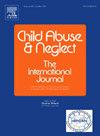Classes of childhood violence victimization and associations with adulthood victimization and mental health in sexual minority young adults
IF 3.4
2区 心理学
Q1 FAMILY STUDIES
引用次数: 0
Abstract
Background
Sexual minority (SM) individuals have alarmingly high rates of victimization during childhood and adolescence, potentially leading to adverse outcomes. Despite this, research on diverse patterns of childhood victimization among SM individuals and their long-term impacts is limited.
Objective
This study uses latent class analysis (LCA) to explore the heterogeneity of childhood victimization among SM individuals and investigate how these patterns relate to mental health and victimization in adulthood.
Participants and setting
The sample included 564 sexual minority young adults (Mage = 22.15, SD = 2.39) from a national probability online survey in the United States.
Methods
We conducted LCA on eight items to assess various types of childhood violence exposure. Kruskal-Wallis tests and Chi-square tests were used to explore differences in adult victimization and mental health outcomes across class membership.
Results
The LCA revealed a three-class model: high family violence exposure (Class 1, 27.3 %), high sexual and family violence exposure (Class 2, 21.1 %), and low violence exposure (Class 3, 51.6 %). Individuals in Classes 1 and 2 exhibited significantly higher levels of psychological distress, suicidal behaviors, and adulthood victimization compared to those in Class 3.
Conclusions
Our findings shed light on the complex patterns of childhood victimization among SM individuals. The results underscore the need for targeted support and intervention services to address childhood victimization as a risk factor for adulthood mental health and victimization exposure within SM populations.
性少数群体青年儿童期暴力受害类别及其与成年期暴力受害和心理健康的关联
性少数群体(SM)在儿童期和青春期的受害率高得惊人,可能导致不良后果。尽管如此,对SM个体中不同的童年受害模式及其长期影响的研究仍然有限。目的利用潜类分析(LCA)探讨SM个体儿童期受害行为的异质性,并探讨这些模式与成年期心理健康和受害行为的关系。样本包括564名来自美国全国概率在线调查的性少数年轻人(Mage = 22.15, SD = 2.39)。方法采用LCA方法对儿童暴力暴露的8个项目进行评估。采用Kruskal-Wallis检验和卡方检验探讨不同班级成员在成人受害和心理健康结果方面的差异。结果LCA显示出高家庭暴力暴露(第1类,27.3%)、高性暴力和家庭暴力暴露(第2类,21.1%)和低暴力暴露(第3类,51.6%)三级模型。班级1和班级2的个体表现出明显高于班级3的个体的心理困扰、自杀行为和成年受害水平。结论研究结果揭示了SM个体儿童期受害的复杂模式。结果强调需要有针对性的支持和干预服务,以解决童年受害是SM人群中成年心理健康和受害暴露的风险因素。
本文章由计算机程序翻译,如有差异,请以英文原文为准。
求助全文
约1分钟内获得全文
求助全文
来源期刊

Child Abuse & Neglect
Multiple-
CiteScore
7.40
自引率
10.40%
发文量
397
期刊介绍:
Official Publication of the International Society for Prevention of Child Abuse and Neglect. Child Abuse & Neglect The International Journal, provides an international, multidisciplinary forum on all aspects of child abuse and neglect, with special emphasis on prevention and treatment; the scope extends further to all those aspects of life which either favor or hinder child development. While contributions will primarily be from the fields of psychology, psychiatry, social work, medicine, nursing, law enforcement, legislature, education, and anthropology, the Journal encourages the concerned lay individual and child-oriented advocate organizations to contribute.
 求助内容:
求助内容: 应助结果提醒方式:
应助结果提醒方式:


